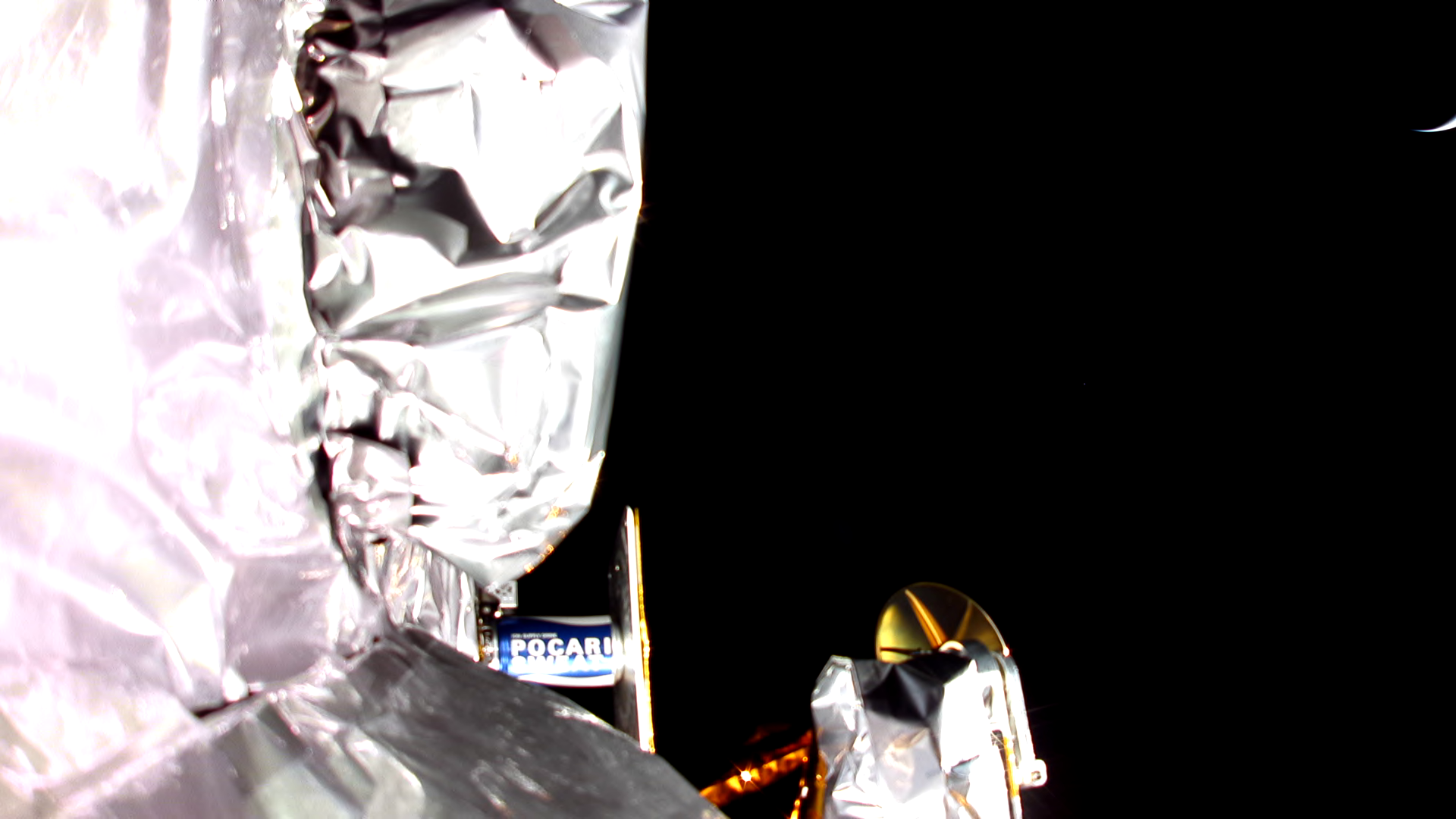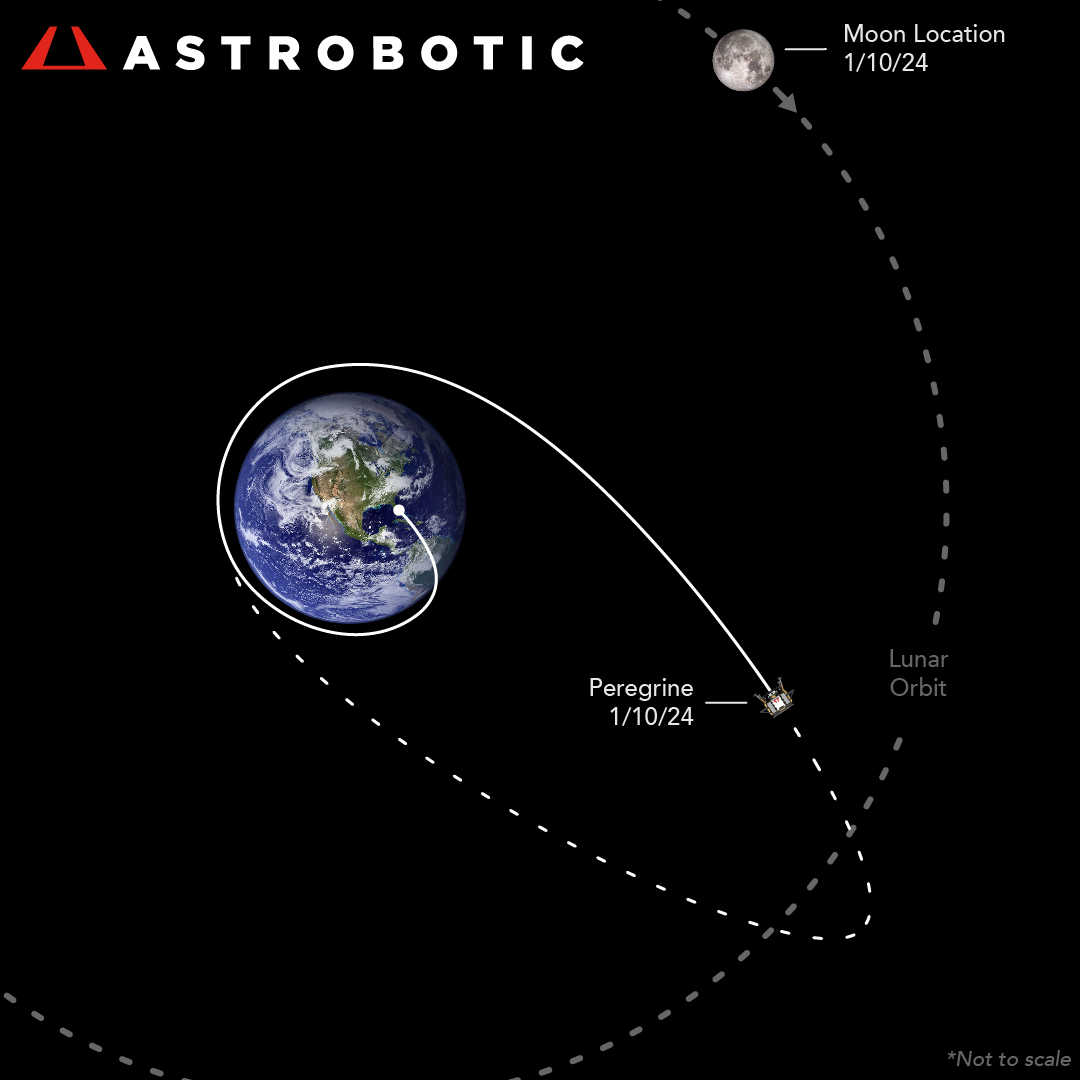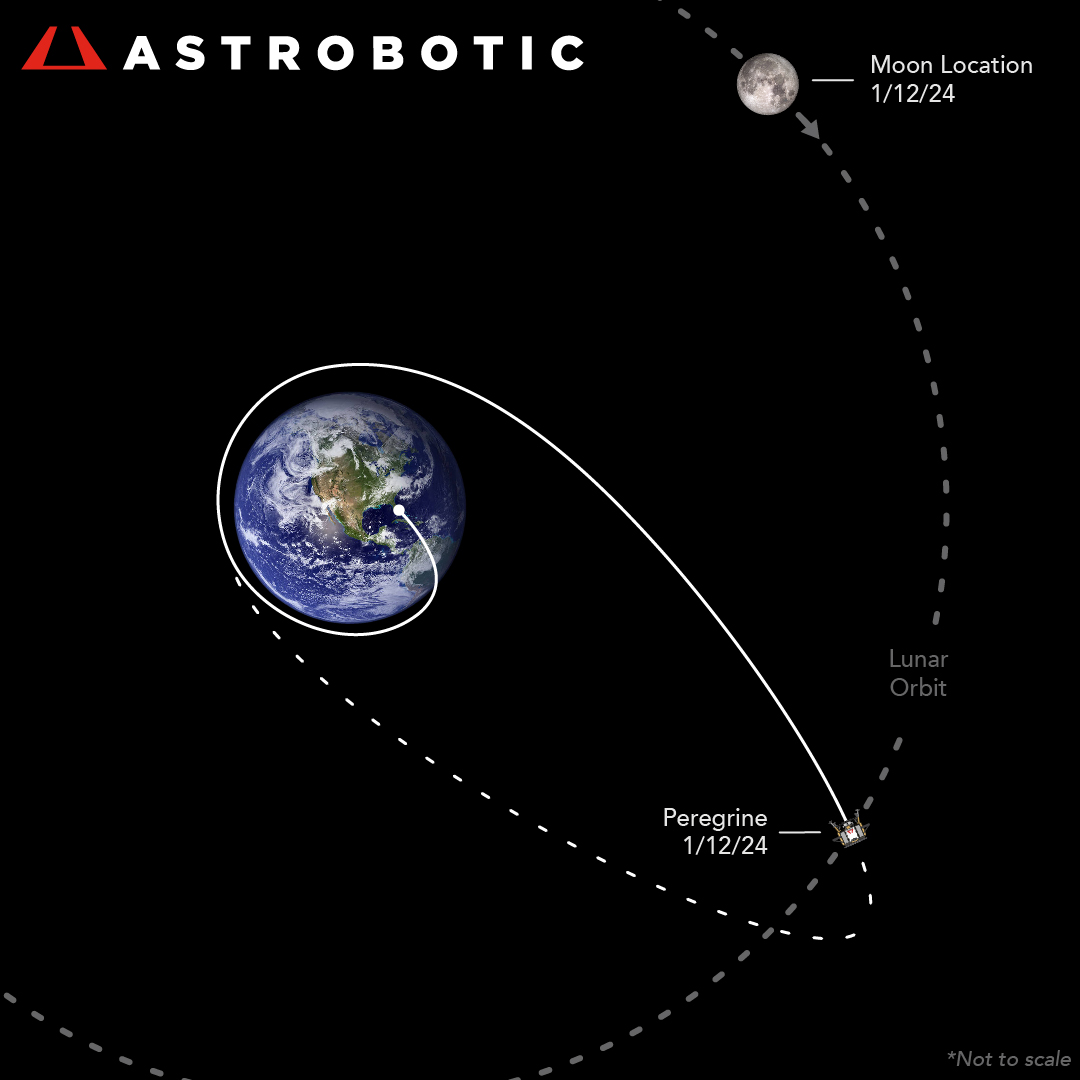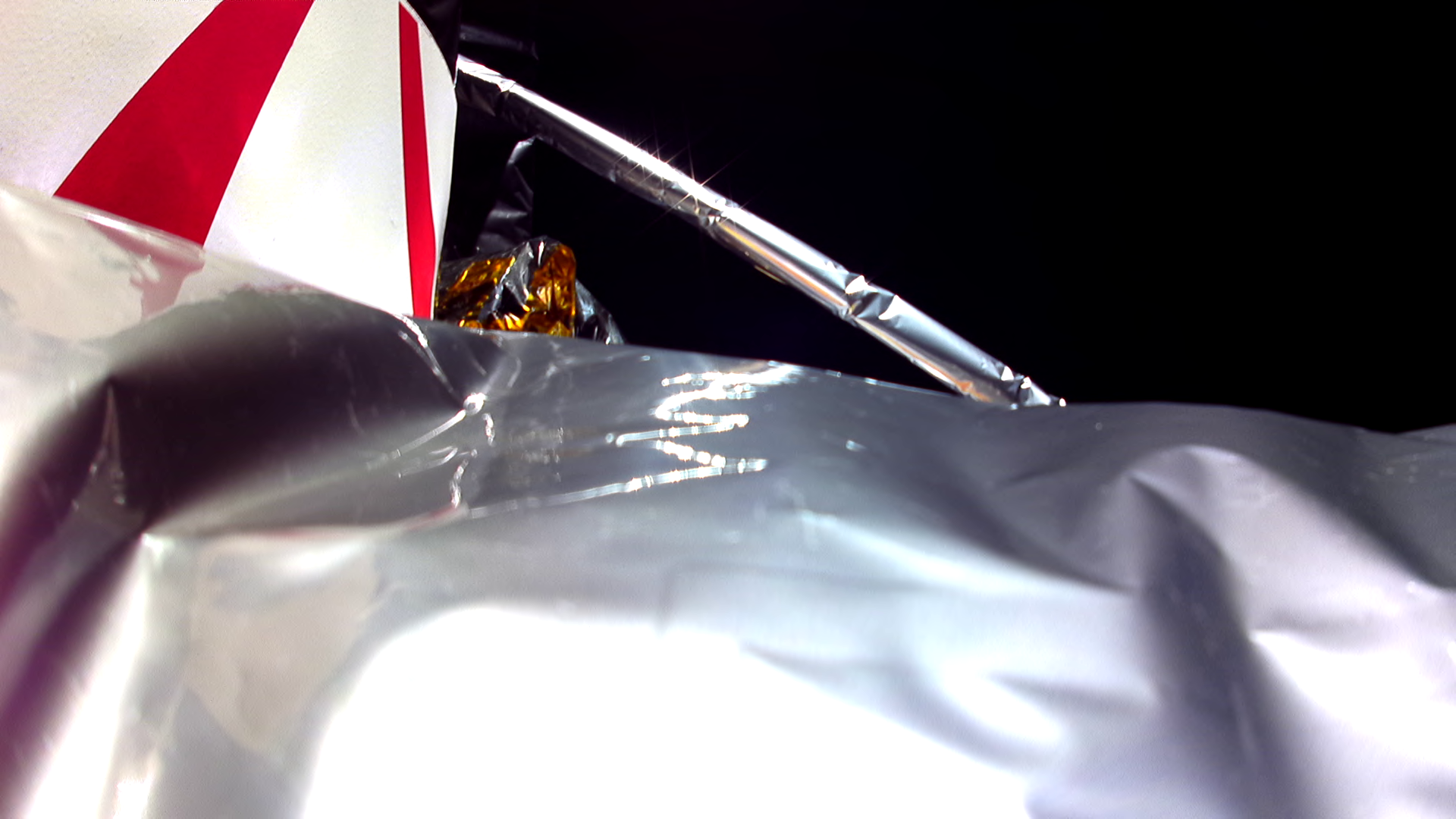Astrobotic’s Peregrine Mission One has successfully launched to the Moon. Peregrine is now flying solo on its way to the Moon, where it will attempt a lunar landing on February 23, 2024. Peregrine could become the first commercial lander, and first American lander in over 50 years, to land on the Moon. At 2:18am ET on January 8, 2024, the company’s Peregrine Lunar Lander lifted off on a United Launch Alliance (ULA) Vulcan rocket from Cape Canaveral Space Force Station in Florida. Peregrine launched on Vulcan’s maiden flight, known as Cert-1. Vulcan lifted Peregrine to an altitude of approximately 500 km above the Earth, where, at approximately 50 minutes after launch, the lander separated from the rocket and successfully powered on. Following separation, Astrobotic successfully contacted the lander and began receiving telemetry.
Peregrine Mission One is the first successful launch under NASA’s Commercial Lunar Payload Services initiative. The mission is delivering scientific instruments and payloads to the Moon’s Gruithuisen Domes region. The NASA instruments aboard Peregrine will help NASA prepare for the Artemis program’s missions to enable a sustained human presence on the Moon. Peregrine is carrying a total of 20 payloads from seven nations and 16 commercial customers. The payloads come from space agencies, universities, companies, and individuals across the globe. This includes the first lunar surface payloads from the Mexican and German space agencies, and the first lunar payloads from the countries of the United Kingdom, Hungary, and Seychelles. One of the payloads, DHL MoonBox, contains mementos and messages from over 100,000 individuals around the world.
UPDATE 1
After successfully separating from United Launch Alliance’s Vulcan rocket, Astrobotic’s Peregrine lunar lander began receiving telemetry via the NASA Deep Space Network. Astrobotic-built avionics systems, including the primary command and data handling unit, as well as the thermal, propulsion, and power controllers, all powered on and performed as expected. After successful propulsion systems activation, Peregrine entered a safe operational state. Unfortunately, an anomaly then occurred, which prevented Astrobotic from achieving a stable sun-pointing orientation. The team is responding in real time as the situation unfolds and will be providing updates as more data is obtained and analyzed.
UPDATE 2
We continue to gather data and report our best assessment of what we see. The team believes that the likely cause of the unstable sun-pointing is a propulsion anomaly that, if proven true, threatens the ability of the spacecraft to soft land on the Moon. As the team fights to troubleshoot the issue, the spacecraft battery is reaching operationally low levels. Just before entering a known period of communication outage, the team developed and executed an improvised maneuver to reorient the solar panels toward the Sun. Shortly after this maneuver, the spacecraft entered an expected period of communication loss. We will provide more updates as Peregrine comes in view of the ground station again.
UPDATE 3
We have successfully re-established communications with Peregrine after the known communication blackout. The team’s improvised maneuver was successful in reorienting Peregrine’s solar array towards the Sun. We are now charging the battery. The Mission Anomaly Board continues to evaluate the data we’re receiving and is assessing the status of what we believe to be the root of the anomaly: a failure within the propulsion system. We are grateful for the outpouring of support we’re receiving – from messages on social media to phone calls and helping hands. This is what makes the space industry so special, that we unite in the face of adversity. A heartfelt thank you from the entire Peregrine Mission One team.
UPDATE 4
Unfortunately, it appears the failure within the propulsion system is causing a critical loss of propellant. The team is working to try and stabilize this loss, but given the situation, we have prioritized maximizing the science and data we can capture. We are currently assessing what alternative mission profiles may be feasible at this time.
UPDATE 5
We’ve received the first image from Peregrine in space! The camera utilized is mounted atop a payload deck and shows Multi-Layer Insulation (MLI) in the foreground. The disturbance of the MLI is the first visual clue that aligns with our telemetry data pointing to a propulsion system anomaly. Nonetheless, the spacecraft’s battery is now fully charged, and we are using Peregrine’s existing power to perform as many payload and spacecraft operations as possible. At this time, the majority of our Peregrine mission team has been awake and working diligently for more than 24 hours. We ask for your patience as we reassess incoming data so we can provide ongoing updates later this evening.

UPDATE 6
The Peregrine spacecraft has now been operational for about 32 hours. Overnight, the team faced another spacecraft pointing issu, but continues to persevere. The spacecraft started to tilt away from the Sun and reduced its solar power generation. The team was able to update the control algorithm and fix the issue.
Given the propellant leak, there is, unfortunately, no chance of a soft landing on the Moon. However, we do still have enough propellant to cotinue to operate the vehicle as a spacecraft. The team has updated its estimates, and we currently expect to run out of peopellant in about 40 hours from now, an improvement from last night's estimate. The team continues to work to find ways to extend Peregrine's operational life. We are in a stable operating mode and are working payload and spacecraft tests and checkouts. We continue receiving valuable data and proving spaceflight operations for components and software relating to our next lunar lander mission, Griffin.
UPDATE 8
Astrobotic’s current hypothesis about the Peregrine spacecraft’s propulsion anomaly is that a valve between the helium pressurant and the oxidizer failed to reseal after actuation during initialization. This led to a rush of high pressure helium that spiked the pressure in the oxidizer tank beyond its operating limit and subsequently ruptured the tank. While this is a working theory, a full analysis report will be produced by a formal review board made up of industry experts after the mission is complete. All available data is being downloaded from the lander to support this assessment. ULA’s Vulcan rocket inserted Peregrine into the planned translunar trajectory without issue. There is no indication that the propulsion anomaly occurred as a result of the launch.
UPDATE 9
We received another beautiful image from Peregrine’s journey! Is that sliver in the upper right corner Earth or a lens flare? The camera that took this image is located on the bottom of one of Peregrine’s payload decks. Just left of center in the image is the DHL MoonBox payload covered in MLI, which contains hundreds of thousands of messages from the people of Earth. Visible to the right of MoonBox and near the bottom center of the photo is Astroscale’s Pocari Sweat Lunar Dream Time Capsule – this was the first payload under contract with Astrobotic and contains messages from children around the world. The bottom center right of the image shows one of Peregrine’s landing legs obscured by the electrical interface where we were connected with the launch vehicle.

UPDATE 10
Peregrine has been operational in space for 55 hours. We are at an approximate distance of 192,000 miles from Earth, which is 80% of the way to lunar distance. Although we are approaching lunar distance, the Moon won’t be there. We remain on our nominal trajectory for the mission, which includes a phasing loop around Earth. This loop goes out to lunar distance, swings back around the Earth, and then cruises out to meet the Moon. This trajectory reaches the Moon in about 15 days post-launch. Peregrine continues to leak propellant but remains operationally stable and continues to gather valuable data. We estimate that we will run out of propellant in about 35 hours, an improvement on yesterday’s update. The team is working around the clock to generate options to extend the spacecraft’s life.

UPDATE 11
Our flight dynamics team has confirmed that the curved sliver in this image taken on our first day of operations is, in fact, Earth! This image from our spacecraft simulator shows the camera’s view of Earth at the time the photo was taken. Peregrine remains stable and fully charged. The spacecraft continues to transmit valuable data. We are now 200,000 miles from earth, which is about 84% of the way to lunar distance. Starting at around 7pm EST, we will enter an expected 9-hour period of Loss of Signal, our longest period without communication yet. We expect to re-establish communication with the spacecraft again at around 4am EST. We estimate that the spacecraft has about 36 hours of propellant remaining, another improvement since this morning.
UPDATE 12
As Peregrine emerges from a planned communications blackout with NASA’s DSN ground network, we’re pleased to announce the team’s efforts to gather payload data have been fruitful. We have successfully received data from all 9 payloads designed to communicate with the lander. All 10 payloads requiring power have received it, while the remaining 10 payloads aboard the spacecraft are passive. These payloads have now been able to prove operational capability in space and payload teams are analyzing the impact of this development now. We are proud of the mission team for achieving this incredible feat under such challenging circumstances. Below are a list of payloads that have received power:
- (pictured) Iris Lunar Rover from Carnegie Mellon University. At the bottom of the overexposed image sent from Peregrine in space are the Iris rover’s wheels. To its left is a fuel tank with the American flag.
- COLMENA from LINX-UNAM (together with Agencia Espacial Mexicana (AEM)
- M-42 Radiation Detector from the German Aerospace Center (DLR)
- Linear Energy Transfer Spectrometer (LETS) from NASA’s Johnson Space Center
- Near-Infrared Volatile Spectrometer System (NIRVSS) from NASA’s Ames Research Center
- Neutron Spectrometer System (NSS) from NASA’s Ames Research Center
- Peregrine Ion Trap Mass Spectrometer (PITMS) from NASA Goddard Space Flight Center, The Open University (OU), NASA, and the European Space Agency (ESA)
- Pocari Sweat’s Lunar Dream Time Capsule from Astroscale
- Optical Precision Autonomous Landing (OPAL) TRN sensor from Astrobotic
- (a subsystem) Navigation Doppler Lidar (NDL) from NASA’s Langley Research Center
UPDATE 13
Since receiving power and telemetry, the Iris Rover payload (pictured) has sent a message from space (pictured). NASA has also released a preliminary science assessment on blogs.nasa.gov: “Two of the payloads, NSS and LETS, are making measurements of the radiation environment in interplanetary space around the Earth and the Moon. The two instruments are measuring different components of the radiation spectrum, which provide complementary insights into the galactic cosmic ray activity and space weather resulting from solar activity. This data helps characterize the interplanetary radiation environment for humans and electronics.” We currently estimate that the spacecraft has about 48 hours of propellant remaining, which is a significant improvement from yesterday. Our estimates for propellant life expectancy have been changing because the rate of the leak has slowed more than anticipated. A slowing leak rate is expected as the pressure drops, but there may be some change in the size of the propulsion system’s rupture as the pressure decreases or some other factor making it difficult to predict. Peregrine has been operating in space for 3 and a half days. It is now 225,000 miles from Earth, which is 94% of lunar distance.

UPDATE 14
Peregrine has now been operational in space for more than 4 days. The spacecraft remains stable and operational, and is currently in a planned loss-of-signal period for about another hour and a half. The leak rate on Peregrine has continued to slow, and the spacecraft is estimated to now have 52 hours of propellant remaining. Our engineers continue to work on solutions to extend life expectancy and there is growing optimism that Peregrine could survive much longer than the current estimate. The payload teams continue to operate and receive power and telemetry from their instruments. Below is a video from the moment the COLMENA payload team began receiving data confirming their payload is now the first Mexican instrument to operate in cislunar space.
UPDATE 15
Peregrine remains operational at about 238,000 miles from Earth, which means that we have reached lunar distance! As we posted in Update #10, the Moon is not where the spacecraft is now (see graphic). Our original trajectory had us arriving at the Moon on day 15 post launch. Our propellant estimates currently have us running out of fuel before this 15-day mark — however, our engineers are still optimistic about extending Peregrine’s life expectancy. On Thursday, January 18, 2024, at NOON ET, Astrobotic is hosting a teleconference with NASA for major mission updates and will be streamed on select NASA channels. With Peregrine operating in a stable configuration and a teleconference imminent, we will post an update tomorrow, but will be slowing down our update cadence for now. Thank you again for the words of support we’ve received for our team.

UPDATE 16
Over the last week, Astrobotic’s Mission Control Center has been tracking Peregrine’s trajectory. Our analysis effort has been challenging due to the propellant leak, which has been adding uncertainty to predictions of the vehicle’s trajectory. Our latest assessment now shows the spacecraft is on a path towards Earth, where it will likely burn up in the Earth’s atmosphere. The team is currently assessing options and we will update as soon as we are able. The propellant leak has slowed considerably to the point where it is no longer the team’s top priority. A reminder that a soft landing on the Moon is not possible. We have now been operating in space for 5 days and 8 hours and are about 242,000 miles from Earth.
UPDATE 17
For 16 years, Astrobotic has been dedicated to making the Moon accessible to the world. The responsible preservation of the cislunar space environment for all is top of mind as we complete this mission. Since the Peregrine lunar lander’s anomaly occurred 6 days ago, we have been evaluating how best to safely end the spacecraft’s mission to protect satellites in Earth orbit as well as ensure we do not create debris in cislunar space. Working with NASA, we received inputs from the space community and the U.S. Government on the most safe and responsible course of action to end Peregrine’s mission. The recommendation we have received is to let the spacecraft burn up during re-entry in Earth’s atmosphere. Since this is a commercial mission, the final decision of Peregrine’s final flight path is in our hands. Ultimately, we must balance our own desire to extend Peregrine’s life, operate payloads, and learn more about the spacecraft, with the risk that our damaged spacecraft could cause a problem in cislunar space. As such, we have made the difficult decision to maintain the current spacecraft’s trajectory to re-enter the Earth’s atmosphere. By responsibly ending Peregrine’s mission, we are doing our part to preserve the future of cislunar space for all.
Despite the propulsion system issue, the Astrobotic Mission Team has worked tirelessly to stabilize the vehicle, turn on all active payloads, and enable the collection of payload data. The spacecraft has been operating in space for 6 days and 16 hours, and Peregrine continues to leak propellant, but now at a very slow rate. Yesterday afternoon, we test fired one of the main engines for the first time. We achieved a 200 millisecond burn and acquired data that indicated Peregrine could have main engine propulsive capability. However, due to the anomaly, the fuel to oxidizer ratio is well outside of the normal operating range of the main engines making long controlled burns impossible. The team projects that the spacecraft has enough remaining propellant to maintain sun pointing and perform small maneuvers.
Astrobotic designed and built hardware, avionics, software, and system architectures that have all performed as expected in space. All payloads designed to power on and communicate did so, and even achieved science objectives. While we believe it is possible for the spacecraft to operate for several more weeks and could potentially have raised the orbit to miss the Earth, we must take into consideration the anomalous state of the propulsion system and utilize the vehicle’s onboard capability to end the mission responsibly and safely. Peregrine will soon return to Earth’s atmosphere and the vehicle is now about 234,000 miles away. We are working with NASA to continue updating and evaluating the controlled re-entry path of Peregrine. We do not believe Peregrine’s re-entry poses safety risks, and the spacecraft will burn up in Earth’s atmosphere. We are validating this through analyses in collaboration with the U.S. Government. We will continue to operate the spacecraft and provide status updates through the end of the mission.
“I am so proud of what our team has accomplished with this mission. It is a great honor to witness firsthand the heroic efforts of our mission control team overcoming enormous challenges to recover and operate the spacecraft after Monday’s propulsion anomaly. I look forward to sharing these, and more remarkable stories, after the mission concludes on January 18. This mission has already taught us so much and has given me great confidence that our next mission to the Moon will achieve a soft landing,” said Astrobotic CEO, John Thornton.
UPDATE 18
Peregrine has been operational in space for 7 days and 13 hours. The spacecraft continues to be responsive, operational, and stable, and remains on its previously reported trajectory toward Earth’s atmosphere. The propellant leak caused by the anomaly has practically stopped. The team continues to work with NASA and U.S. Government agencies to assess the final trajectory path in which the vehicle is expected to burn up. Peregrine is now about 218,000 miles away from Earth. This photo was taken in space today, with a camera on one of Peregrine’s payload decks. This is the same camera view as the first photo we received from the spacecraft on January 8, 2024.

UPDATE 19
The Peregrine spacecraft continues to be responsive and stable and has been operational in space for 8 days and 16 hours. The mission team is continuously monitoring the spacecraft’s trajectory back to Earth. We remain in contact with our U.S. Government partners to ensure as safe a re-entry path as possible. As a reminder, Peregrine reached apogee on Saturday and is now about 183,000 miles from Earth.
Source: Astrobotic Technology

